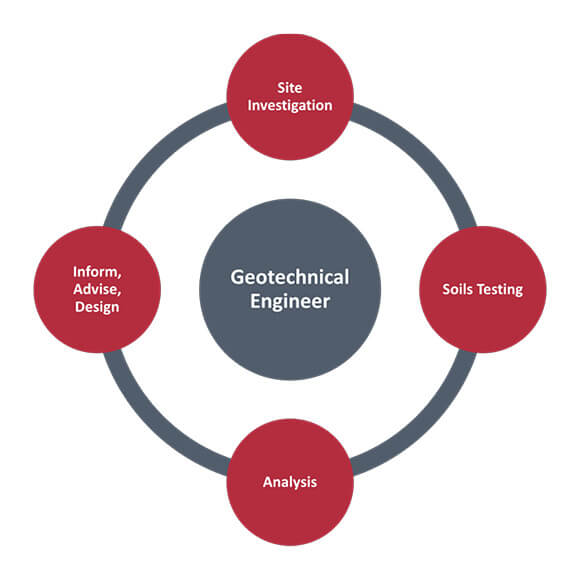The smart Trick of Geotheta That Nobody is Talking About
Table of ContentsWhat Does Geotheta Mean?Excitement About GeothetaGeotheta Fundamentals ExplainedOur Geotheta StatementsGeotheta for Dummies

They perform website examinations, collect examples, do laboratory tests, and evaluate information to examine the viability of the ground for construction jobs - Geo Tech Engineer. Based on their findings, geotechnical engineers offer suggestions for foundation layout, slope stability, preserving frameworks, and mitigation of geotechnical risks. They collaborate with various other experts, such as designers, structural designers, and construction groups, to make sure that geotechnical factors to consider are incorporated into the overall project layout and implementation
By analyzing the actions and residential or commercial properties of dirt and rock, they can identify potential geotechnical hazards such as landslides, soil negotiation, or slope instability. Their competence aids stop failings or accidents that can threaten lives and home. Here are some in-depth tasks and responsibilities of a geotechnical engineer: Website Investigation: Geotechnical engineers conduct website investigations to gather information on subsurface conditions.
They translate the data to comprehend the properties and behavior of the soil and rock, including their strength, permeability, compaction qualities, and groundwater conditions. Geotechnical Evaluation and Style: Geotechnical engineers assess the data accumulated during website examinations to examine the security and viability of the website for building projects. They carry out geotechnical estimations and modeling to review factors such as bearing ability, settlement, incline stability, side earth pressures, and groundwater circulation.
3 Simple Techniques For Geotheta
Foundation Layout: Geotechnical engineers play a critical duty in developing foundations that can securely support the desired framework. They examine the dirt conditions and tons demands to figure out the ideal structure kind, such as superficial foundations (e.g., grounds), deep foundations (e.g (https://geotheta.wordpress.com/2024/08/02/unlocking-the-secrets-of-geotechnical-engineers-the-geotheta-advantage/)., piles), or specialized methods like soil improvement. They consider factors such as negotiation restrictions, bearing capability, and soil-structure interaction to develop optimal foundation styles
They assess building and construction plans, display website tasks, and perform area evaluations to verify that the design suggestions are followed. If unforeseen geotechnical issues emerge, they evaluate the circumstance and offer recommendations for remediation or changes to the style. Threat Analysis and Reduction: Geotechnical engineers evaluate geotechnical dangers and threats related to the project site, such as landslides, liquefaction, or soil erosion.

Collaboration and Interaction: Geotechnical designers function closely with various other professionals entailed in a job, such as engineers, structural designers, and construction groups. Effective interaction and collaboration are vital to incorporate geotechnical factors to consider into the total task design and construction process. Geotechnical designers offer technical knowledge, solution queries, and guarantee that geotechnical needs are met.
6 Simple Techniques For Geotheta
Below are some types of geotechnical engineers: Foundation Designer: Structure designers specialize in creating and assessing structures for structures. They assess the soil problems, load needs, and website characteristics to establish the most suitable foundation type and layout, such as superficial structures, deep foundations, or specialized techniques like pile structures.
They review the variables affecting incline stability, such as soil residential properties, groundwater problems, and incline geometry, and create approaches to avoid incline failings and alleviate dangers. Earthquake Engineer: Earthquake designers concentrate on analyzing and making frameworks to stand up to seismic forces. They evaluate the seismic hazard of a website, review soil liquefaction possibility, and develop seismic design standards to make sure the security and resilience of frameworks during earthquakes.
They perform area testing, collect samples, and analyze the gathered data to identify the soil properties, geologic developments, and groundwater conditions at a website. Geotechnical Instrumentation Engineer: Geotechnical instrumentation designers concentrate on tracking and measuring the behavior of dirt, rock, and structures. click here now They set up and maintain instrumentation systems that check aspects such as dirt settlement, groundwater degrees, incline movements, and architectural displacements to examine performance and offer very early warnings of possible issues.
Not known Factual Statements About Geotheta
They conduct examinations such as triaxial examinations, consolidation examinations, straight shear examinations, and permeability tests to collect information for geotechnical analysis and style. Geosynthetics Designer: Geosynthetics engineers specialize in the style and application of geosynthetic products, such as geotextiles, geogrids, and geomembranes. They use these products to boost dirt stability, strengthen slopes, provide drainage remedies, and control erosion.
They tend to be investigative people, which means they're intellectual, introspective, and inquisitive. They are curious, methodical, rational, analytical, and logical. Some of them are likewise social, suggesting they're kind, charitable, cooperative, individual, caring, helpful, understanding, skillful, and pleasant. Does this seem like you? Take our totally free occupation test to figure out if geotechnical engineer is among your leading occupation matches.
In the office environment, geotechnical designers use specialized software program devices to carry out calculations, develop styles, and analyze information. They prepare reports, review task specs, communicate with customers and team participants, and coordinate job activities. The workplace setting provides a favorable setting for research study, evaluation, and collaboration with various other professionals involved in the job.
Geotheta - Questions
They regularly go to task sites to carry out website examinations, evaluate geotechnical problems, and collect data for evaluation. These sees involve traveling to various locations, often in remote or difficult surfaces. Geotechnical designers may execute soil sampling, conduct examinations, and monitor building and construction activities to ensure that the geotechnical elements of the task are being executed appropriately.
Geotechnical engineers also operate in specialized geotechnical laboratories. In these facilities, they perform experiments, perform tests on dirt and rock examples, and examine the design properties of the materials. Geotechnical research laboratory engineers work extensively in these settings, taking care of testing devices, operating instruments, and taping data. They collaborate with other lab team to ensure accurate and trusted screening outcomes.